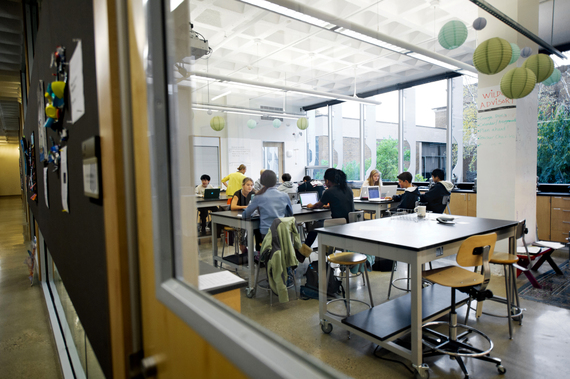This article originally appeared on EdSurge on May 3, 2015.
As the head of Beaver Country Day School, a co-ed school for grades 6-12 that has adopted a unique approach to coding in the curriculum, I very much enjoyed this article, "Coding Is Coming To Every Industry You Can Think Of, Time To Start Learning It Now." Coding is, indeed, everywhere today. And while not all of our students will be coders or engineers, they all need to acquire a level of coding literacy that will enable them to understand the power of coding in any career direction they choose.
Central to our "coded curriculum" initiative is our commitment to breaking down all the stereotypes that are associated with coding--especially the idea that coding is for boys who are born with innate mystical powers that only they understand, that it's a language only they can speak. By embedding coding into all subjects and grades, we have demythologized and demystified coding for all students. Yes--that means every girl who graduates from Beaver will know how to write code. That's huge!
So how have we done this? Two years ago we decided to teach students to write code as a problem solving tool in geometry. Geometry is a course where logic, spatial reasoning and problem-solving are the big skills we're trying to build, and all of those skills can be built through coding. It seemed like a great place to start; the plan was to eventually expand this approach into various other classes in order to fully integrate coding into our curriculum.
Surprise! Within two months, teachers in every department in every grade were finding ways coding could expand possibilities for work in their disciplines. English students used code to digitally act out scenes from Macbeth and analyze poetry; art students created drawings like this one; modern language students used code to make vocabulary flashcards; 7th grade history students coded historical statistics. At the end of the year, we discovered that every student in the school had had at least one meaningful experience with writing code.
We do not think of coding as a graduation requirement because in our approach we do not see coding as a distinct skill or thing. We think of coding as a problem solving tool that supports higher order problem solving. I agree with Mitch Resnick, Director of the Lifelong Kindergarten group at the MIT Media Lab, when he compares coding to writing, which is not just about producing grammatically correct prose, but about communicating with a purpose--to persuade, describe, argue, develop a voice and understand an audience. Coding, like writing, is a very, very powerful tool.
But wait. This sounds great for a small private school, but how might this work in a larger public, charter or parochial school? The beauty of this approach is that once the infrastructure is in place, the costs are reasonable, and the results are more sustainable for students. While we have invested in faculty development, we did not need to add any new staff members. Most of the materials we deal with are open source, and hardware costs are coming down. A $150 Chromebook works just fine; so do free coding resources like PencilCode and Khan Academy. Our approach was well received in 2014 and 2015 at SWSXedu and in a recent Education Week Twitter chat, which further discussed how both public and private schools can learn from each other when it comes to using technology in the classroom.
At Beaver, we are fully committed to teaching students what we call the "New Basics:"
- Creative Problem Solving
- Collaboration
- Iteration
- Visual Communication
- Empathy
- Tech & Media Literacy, and
- Presentation Skills
These are our "unwritten graduation requirements." In this context, coding is a both a skill and a tool that has the capacity to deepen students' access to those New Basics. It is a tool that enables students to demonstrate what they can do and what they know.
A student might write code to recreate what happens in the murder scene in Macbeth. Engineering and design students use code to design a Rescue Robot that could save soldiers' lives in the battle field. History students use code to create infographics and simulations. Sixth grade math students use code as a new way to approach problem solving. Coding is another tool to give students the opportunity to do real work, not realistic work.
If coding is really going to have an impact, we need to find ways to make it stick--particularly with students who do not initially see themselves as coders. This will never happen in standalone computer science classes that usually just attract students who already write code. As with any learning, the only way to make it stick is to demonstrate its utility and its power for everyone--future artists, historians, biologists, parents.
Coding at Beaver is gradually becoming normalized, and we are approaching the next level where it is just part of what we do in school without realizing we are doing it. I can't wait to see where we are in next few years.
Peter Hutton has been Head of Beaver Country Day School, one of the nation's leading independent schools for grades 6-12, since 1992.
